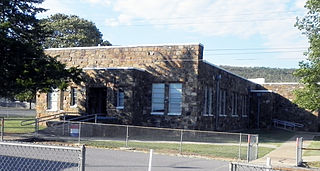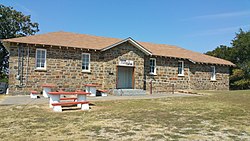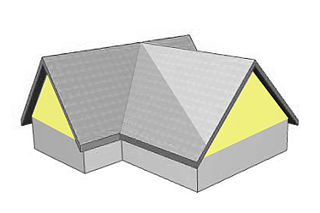
Pushmataha County is a county located in the southeastern part of the U.S. state of Oklahoma. As of the 2010 census, the population was 11,572. Its county seat is Antlers.

Clayton is a town in Pushmataha County, Oklahoma, United States. The population was 1,012 at the 2010 census.

Tuskahoma is an unincorporated community and census-designated place in northern Pushmataha County, Oklahoma, four miles east of Clayton. The population at the 2010 census was 151.

Nashoba is an unincorporated community in Pushmataha County, Oklahoma, 11 miles southeast of Tuskahoma.

Williams School in Cameron, Oklahoma was a Works Progress Administration project that was built in 1936. It was listed on the National Register of Historic Places in 1988.
Kellond is an unincorporated community and former railroad station in Pushmataha County, Oklahoma. Kellond is located approximately three miles northwest of Antlers on Oklahoma State Highway 2.

The Frisco Depot and adjacent Antlers Spring are historic sites in Antlers, Oklahoma, United States. The sites are a part of the National Register of Historic Places, in which they appear as a single entry.

Fewell School is a historic site located in Fewell, Oklahoma. Fewell, 10 miles east of Nashoba, Oklahoma, is a rural community in the Kiamichi Mountains of Pushmataha County, Oklahoma.

Clayton High School Auditorium is an historic structure serving the public school of Clayton, Oklahoma. Clayton is located in the Kiamichi Mountains of Pushmataha County, Oklahoma.
The Summerfield School, located off US 271 in Summerfield, Oklahoma, USA, was built in 1937 as a Works Progress Administration project. It was listed on the National Register of Historic Places in 1988.

The Manhattan School is a historic schoolhouse located on Gold Street in Manhattan, Nevada. Built in 1913, the school was the third in Manhattan. The first school had opened in 1906, shortly after a gold rush in the community, and the second opened in 1908; however, by 1911 the local school district had 65 students and had outgrown its original buildings. Manhattan's voters unanimously passed a bond proposal for the new school the following year. Area contractor Angus McDonald built the school the year after. Upon its completion, a benefit party was held at the school to provide money for its furniture and a piano.

The Coalgate School Gymnasium-Auditorium is a historic school building in Coalgate, Oklahoma. It is located at the intersection of Fox and Frey streets in Coalgate, Oklahoma and is one of several properties in Southeastern Oklahoma constructed by the Works Progress Administration during the Great Depression. It is listed on the National Register of Historic Places.

The Arkoma School in Arkoma in Le Flore County, Oklahoma was a Works Progress Administration-funded project completed in 1937. It was listed on the National Register of Historic Places in 1988.

The Dog Creek School, near Shady Point, Oklahoma, is a one-room school built in 1936 as a Works Progress Administration project. It was listed on the National Register of Historic Places in 1988.

The Tucker School was a three-room schoolhouse built in 1937 as a Works Progress Administration project in a rural area outside of Spiro in LeFlore County, Oklahoma. It was listed on the National Register of Historic Places in 1988.

The Shady Point School, located on the northeastern edge of the community of Shady Point in Le Flore County, Oklahoma, was built in 1936 as a Works Progress Administration project. It was listed on the National Register of Historic Places in 1988.

The Poteau School Gymnasium-Auditorium, located at Walter and Parker Sts. in Poteau in Le Flore County, Oklahoma, was built in 1937. It was listed on the National Register of Historic Places in 1988.

The Robert E. Lee School, at Ninth and Louisiana Streets in Durant, Oklahoma, was built in 1937. It was listed on the National Register of Historic Places in 1988.

















